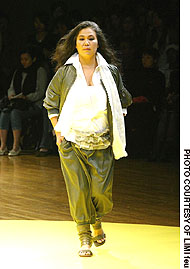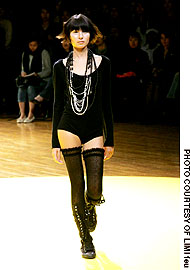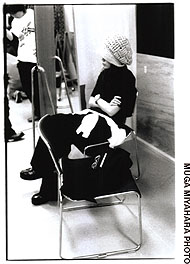She may be Yohji's daughter, but Limi Yamamoto wasn't exactly born clutching a silver spoon. Her parents got divorced when she turned 2 years old, and the next 15 years were spent in a small town in Kyushu, where she saw her father once every three years or so.
Then, in her senior year in high school, Yohji took Limi to New York to show his collection. It was the first time she had seen her father's work on the runway, and Limi recalls: "I was so overcome, I just started crying."
Then and there she decided to become a designer, though she had had no prior ambitions to do so.
"I was far from being fashionable. I thought the whole business of decorating oneself was phony and tacky," she says of herself before that moment.
Now 31, Limi Yamamoto has matured into one of the most charismatic designers of her generation, and helms her own brand called LIMI feu, with eight outlets nationwide including flagship boutiques in Tokyo -- one in upscale Daikanyama and the other in young hipster Harajuku. The latter venue has become a gathering spot for the alternative Harajuku girl: a little tough, a little cerebral, markedly more complex and sophisticated than the crowd shopping at BAPY or on Takeshita-dori. In fact, they seem a lot like Limi when she first started out as a patternist in Yohji's company. ("Yohji would always walk into the pattern room just when I was munching on snacks and calling a friend," she recalls with a laugh.)
She made her Tokyo Collection debut in 2000, at age 24. Back then the brand was called Y's bis, and Limi and Yohji fans were struck by the designs that seemed to take the essential components of Yohji's designs and translate/edit them for young women. The prices, too, were more affordable than her father's stuff. Indeed, she herself says, "I still can't get over how expensive designer brands are, and the lengths women go to to buy them. Normal, working single women can't spend that much on clothes."
This isn't to say that LIMI feu is hugely affordable -- it's not. But the prices are set within a range that young women can reach, with marginally less damage to their wallets. (A beautifully cut white shirt, for example, will set you back less than 20,000 yen, and most jackets are set between 30,000 yen and 60,000 yen.)
In contrast to Yamamoto Sr., who has consistently sought to define and redefine his personal notion of the ideal woman (clean, sharp, mysterious, muting her sexuality under the voluminous folds of her Yohji dress), Limi has actively tried to bend current standards of Japanese femininity to match her own.
"I'm a woman and know how women feel. This is what I have going for me -- my father can't compete with that."
Accordingly, Limi's works have evolved from reinterpretations of her father's work to reflecting her own inner landscape. Now married and the mother of two babies (1- and 2-years old), Limi's latest 2006 Spring/Summer Collection that she showcased in Tokyo last week explores once again what it means to be a Japanese woman living and working in this workcentric land.
This time she reached out to all segments of the populace, from teenager to grandmother -- and the effect is at once intimate and universal. Limi had always had particular tastes in assembling her models and, unlike her fellow designers (or her father), she's famed for working almost exclusively with a trusted stable of Japanese models -- though one time she put together a small corps of teenage girls, all under 160 cm tall. For many in the audience it was obviously quite arresting to see the young, tiny young ladies on the runway, but to critics who complained about "amateurishness," Limi replied: "I design my clothes for Japanese women, who are by definition short-statured and skinny. Why pretend otherwise?"
In this latest collection, small gasps erupted from the audience as models in their 40s, 50s and 60s strode the runway -- in Limi's signature style of cerebral street girl. Among them was actress Jun Togawa, famed for her over-the-top, self-destructive lifestyle. Donning a flounced-out, black lace skirt (the collection's theme item) Togawa was stunning: a matured, defiant Alice in Wonderland dressed for a second round of tea with the Mad Hatter.
"This time, I wanted to demonstrate how cool older women can be," said Limi. "I was really happy about the result -- they looked fabulous, like they had just pulled these clothes out of their closets and worn them because they happened to feel like it. These women are inspiring for me, they give me something to aim for."
Limi says she is probably at the busiest time of her life: struggling to juggle family and work and still maintain her creativeness -- and the muted, crazy energy that defines her work.
Is she interested in taking her work overseas? "Not for the moment. To me, the Japanese working woman is the most demanding, fashion-conscious consumer in the world. I feel that I have to convince her first, before I convince anyone else."





















With your current subscription plan you can comment on stories. However, before writing your first comment, please create a display name in the Profile section of your subscriber account page.